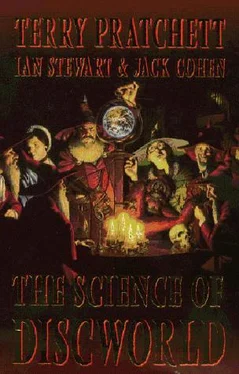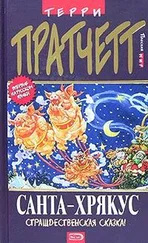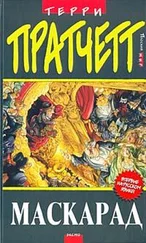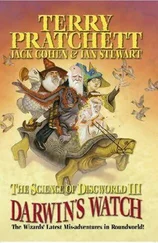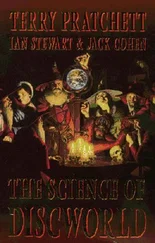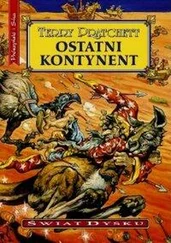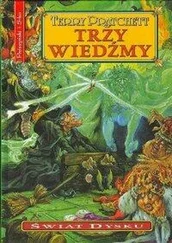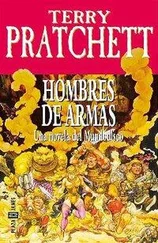Terry Pratchett - Science of Discworld
Здесь есть возможность читать онлайн «Terry Pratchett - Science of Discworld» весь текст электронной книги совершенно бесплатно (целиком полную версию без сокращений). В некоторых случаях можно слушать аудио, скачать через торрент в формате fb2 и присутствует краткое содержание. Жанр: Фантастика и фэнтези, на английском языке. Описание произведения, (предисловие) а так же отзывы посетителей доступны на портале библиотеки ЛибКат.
- Название:Science of Discworld
- Автор:
- Жанр:
- Год:неизвестен
- ISBN:нет данных
- Рейтинг книги:4 / 5. Голосов: 1
-
Избранное:Добавить в избранное
- Отзывы:
-
Ваша оценка:
- 80
- 1
- 2
- 3
- 4
- 5
Science of Discworld: краткое содержание, описание и аннотация
Предлагаем к чтению аннотацию, описание, краткое содержание или предисловие (зависит от того, что написал сам автор книги «Science of Discworld»). Если вы не нашли необходимую информацию о книге — напишите в комментариях, мы постараемся отыскать её.
Science of Discworld — читать онлайн бесплатно полную книгу (весь текст) целиком
Ниже представлен текст книги, разбитый по страницам. Система сохранения места последней прочитанной страницы, позволяет с удобством читать онлайн бесплатно книгу «Science of Discworld», без необходимости каждый раз заново искать на чём Вы остановились. Поставьте закладку, и сможете в любой момент перейти на страницу, на которой закончили чтение.
Интервал:
Закладка:
Enter Edwin Hubble, an American astronomer. Hubble was observing distant stars, and he made a curious discovery. The further away the stars were, the faster they were moving. He knew this for distinctly indirect, but scientifically impeccable, reasons. Stars emit light, and light has many different colours, including 'colours' that the human eye is unable to see, colours like infra-red, ultra-violet, radio, x-ray ... Light is an electromagnetic wave, and there is one 'colour' for each possible wavelength of light, the distance from one electromagnetic peak to the next. For red light, this distance is 2.8 hundred thousandths of an inch (0.7 millionths of a metre).
Hubble noticed that something funny was happening to the light emitted by stars: the colours were shifting in the red direction. The further away a star was, the bigger the shift. He interpreted this 'red shift' as a sign that the stars are moving away from us, because there is a similar shift for sound, known as the 'Doppler effect', and it's caused by the source of the sound moving. So the further away the stars are, the faster they're travelling. This means that the stars aren't just moving away from us, they're moving away from each other, like a flock of birds dispersing in all directions.
The universe, said Hubble, is expanding.
Not expanding into anything, of course. It's just that the space inside the universe is growing . That made the physicists' ears prick up, because it fitted exactly one of their three scenarios for changes in the size of the universe: stay the same, grow, collapse. They 'knew' it had to be one of the three, but which? Now they knew that, too. If we accept that the universe is growing we can work out where it came from by running time backwards, and this time-reversed universe collapses back to a single point. Putting time the right way round again, it must all have grown from a single point -the Big Bang. By estimating the rate of expansion of the universe we can work out that the Big Bang happened about 15 billion years ago.
There is further evidence in the Big Bang's favour: it left 'echoes'. The Big Bang produces vast amounts of radiation, which spreads through the universe. Because the universe is spherical, the radiation eventually comes back on itself like a round-the-world traveller. Over billions of years, the remnants of the Big Bang's radiation smeared out into the 'cosmic background', a kind of low-level simmering of radiant energy across the sky, the light analogue of a reverberating echo of sound. It is as if God shouted 'Hello!' at the instant of creation and we can still hear a faint 'elloelloelloelloeiio ...' from the distant mountains. On Discworld this is exactly the case, and the Listening Monks in their remote temples spend their whole lives straining to pick out from the sounds of the universe the faint echoes of the Words that set it in motion.
According to the details of the Big Bang, the cosmic background radiation should have a 'temperature' (the analogue of loudness) of about 3° Kelvin (0° Kelvin is the coldest anything can get, equivalent to about -273° Celsius). Astronomers can measure the temperature of the cosmic background radiation, and they do indeed get 3° Kelvin. The Big Bang isn't just a wild speculation. Not so long ago, most scientists didn't want to believe it, and they only changed their minds because of Hubble's evidence for the expansion of the universe, and that impressively accurate figure of 3° Kelvin for the temperature of the cosmic background radiation.
It was, indeed, a very loud, and hot, bang.
We are ambivalent, then, about beginnings, their 'creation myth' aspect appeals to our sense of narrative imperative, but we sometimes find the 'first it wasn't, then it was' lie-to-children unpalatable. We have even more trouble with becomings. Our minds attach labels to things in the surrounding world, and we interpret those labels as discontinuities. If things have different labels, then we expect there to be a clear line of demarcation between them. The universe, however, runs on processes rather than things, and a process starts as one thing and becomes another without ever crossing a clear boundary. Worse, if there is some apparent boundary, we are likely to point to it and shout 'that's it!' just because we can't see anything else worth getting agitated about. How many times have you been in a discussion in which somebody says 'We have to decide where to draw the line'? For instance, most people seem to accept that in general terms women should be permitted abortions during the earliest stages of pregnancy but not during the very late stages. 'Where you draw the line', though, is hotly debated, and of course some people wish to draw it at one extreme or the other. There are similar debates about exactly when a developing embryo becomes a person, with legal and moral rights. Is it at conception? When the brain first forms? At birth? Or was it always a potential person, even when it 'existed' as one egg and one sperm?
The 'draw a line' philosophy offers a substantial political advantage to people with hidden agendas. The method for getting what you want is first to draw the line somewhere that nobody would object to, and then gradually move it to where you really want it, arguing continuity all the way. For example, having agreed that killing a child is murder, the line labelled 'murder' is then slid back to the instant of conception; having agreed that people should be allowed to read whichever newspaper they like, you end up supporting the right to put the recipe for nerve gas on the Internet.
If we were less obsessed with labels and discontinuity, it would be much easier to recognize that the problem here is not where to draw the line: it is that the image of drawing a line is inappropriate. There is no sharp line, only shades of grey that merge unnoticed into one another, despite which, one end is manifestly white and the other is equally clearly black. An embryo is not a person, but as it develops it gradually becomes one. There is no magic moment at which it switches from non-person to person, instead, it merges continuously from one into the other. Unfortunately our legal system operates in rigid black-and-white terms, legal or illegal, no shades of grey, and this causes a mismatch, reinforced by our use of words as labels. A kind of triage might be better: this end of the spectrum is legal, that end of the spectrum is illegal, and in between is a grey area which we do our best to avoid if we possibly can. If we can't avoid it, we can at least adjust the degree of criminality and the appropriate penalty according to whereabouts in the spectrum the activity seems to lie.
Even such obviously black-and-white distinctions as alive/dead or male/female turn out, on close examination, to be more like a continuous merging than a sharp discontinuity. Pork sausages from the butcher's contain many live pig cells. With today's techniques you might even clone an adult pig from one. A person's brain can have ceased to function but their body, with medical assistance, can keep going. There are at least a dozen different combinations of sex chromosomes in humans, of which only XX represents the traditional female and XY the traditional male.
Although the Big Bang is a scientific story about a beginning, it also raises important questions about becomings. The Big Bang theory is a beautiful bit of science, very nearly consistent with the picture we now have of the atomic and the subatomic world, with its diverse kinds of atom, their protons and neutrons, their clouds of electrons, and the more exotic particles that we see when cosmic rays hit our atmosphere or when we insult the more familiar particles by slamming them together very hard. Now that physicists have 'found', or perhaps invented, the allegedly 'ultimate' constituents of these familiar particles (more exotic things known as quarks, glu-ons ... at least the names are familiar) they're starting to wonder whether there are more layers further down, more 'ultimate' still.
Читать дальшеИнтервал:
Закладка:
Похожие книги на «Science of Discworld»
Представляем Вашему вниманию похожие книги на «Science of Discworld» списком для выбора. Мы отобрали схожую по названию и смыслу литературу в надежде предоставить читателям больше вариантов отыскать новые, интересные, ещё непрочитанные произведения.
Обсуждение, отзывы о книге «Science of Discworld» и просто собственные мнения читателей. Оставьте ваши комментарии, напишите, что Вы думаете о произведении, его смысле или главных героях. Укажите что конкретно понравилось, а что нет, и почему Вы так считаете.
